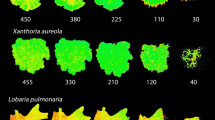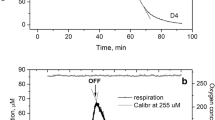Abstract
Measurements were made of net rates of CO2 assimilation in lichens at various ambient concentrations of CO2 in air and in helox (79% He, 21% O2). Because of the faster rate of CO2 diffusion in the pores of lichen thalli when filled with helox than when filled with air, a given net rate of assimilation was achieved at a lower ambient concentration of CO2 in helox. The differences were used to estimate resistances to diffusion through the gas-filled pore systems in lichens. The technique was first tested with five lichen species, and then applied in a detailed study with Ramalina maciformis, in which gas-phase resistances were determined in samples at four different states of hydration and with two irradiances. By assuming, on the basis of previous evidence, that the phycobiont in R. maciformis is fully turgid and photosynthetically competent at the smallest hydration imposed (equilibration with vapour at 97% relative humidity), and that, with this state of hydration, diffusion of CO2 to the phycobiont takes place through continuously gas-filled pores, it was possible also to determine both the dependence of net rate of assimilation in the phycobiont on local concentration of CO2 in the algal layer, and, with the wetter samples, the extents to which diffusion of CO2 to the phycobiont was impeded by water films. In equilibrium with air of 97% relative humidity, the thallus water content being 0.5 g per g dry weight, the resistance to CO2 diffusion through the thallus was about twice as large as the resistance to CO2 uptake within the phycobiont. Total resistance to diffusion increased rapidly with increase in hydration. At a water content of 2 g per g it was about 50 times as great as the resistance to uptake within the phycobiont and more than two-thirds of it was attributable to impedance of transfer by water. The influences of water content on rate of assimilation at various irradiances are discussed. The analysis shows that the local CO2 compensation concentration of the phycobiont in R. maciformis is close to zero, indicating that photorespiratory release of CO2 does not take place in the alga, Trebouxia sp., under the conditions of these experiments.
Similar content being viewed by others
Abbreviations
- α:
-
rate of CO2 diffusion in air relative to that in carrier gas (unity if the carrier gas is air and 0.43 if is helox)
- A1 :
-
net rate of CO2 uptake by the lichen
- Ap :
-
gross rate of carboxylation minus photorespiratory decarboxylation in the phycobiont, i.e. net rate of light-activated CO2 exchange
- A* :
-
maximum, CO2-saturated magnitude of Ap
- c:
-
concentration of CO2
- ca :
-
ambient concentration of CO2
- ci :
-
ca minus difference in CO2 concentration across air-filled pore space in the thallus
- c8 :
-
CO2 concentration equivalent to partial pressure of CO2 at the surface of the phycobiont
- Γ1 :
-
magnitude of ca at which A1 = 0
- Γ* :
-
magnitude of c* at which Ap = 0
- R:
-
rate of “dark respiration” in the lichen (mycobiont and phycobiont)
- R′:
-
rate of “dark respiration” in region between the surface of the lichen and an arbitrary distance from the surface within the thallus
- r:
-
resistance to CO2 transfer from lichen surface to the surface of the phycobiont
- r† :
-
resistance to CO2 transfer between effective source of “dark respiration” in the lichen and the surface of the phycobiont
- rg, r †g :
-
components of r and r†, respectively, attributable to transfer in air-phase
- rw, r †w :
-
components of r and r†, respectively, attributable to transfer in water-phase
- r′:
-
component of r between surface of lichen and an arbitrary distance from the surface within the thallus
- r* :
-
resistance to CO2 transfer and carboxylation in the phycobiont
- RH:
-
relative humidity
References
Badger, M.R. (1989) The CO2-concentrating mechanism in aquatic phototrophs. In: The biochemistry of plants, vol. 10, pp. 219–274, Hatch, M.D., Boardman, N.K., eds. Academic Press, San Diego, etc.
Bauer, H. (1984) Net photosynthetic CO2 compensation concentrations of some lichens. Z. Pflanzenphysiol. 114, 45–50
Beyschlag, W., Lange, O.L., Tenhunen, J.D. (1986) Photosynthese und Wasserhaushalt der immergrünen mediterranen Hartlaubpflanze Arbutus unedo L. im Jahreslauf am Freilandstandort in Portugal. I. Tagesläufe von CO2-Gaswechsel und Transpiration unter natürlichen Bedingungen. Flora 178, 409–444
Brown, R.H. (1980) Photosynthesis of grass species differing in carbon dioxide fixation pathways. IV. Analysis of reduced oxygen response in Panicum milioides and Panicum schenkii. Plant Physiol. 65, 346–349
Büdel, B., Lange, O.L. (1991) Water status of green and blue-green phycobionts in lichen thalli after hydration by water vapor uptake: do they become turgid? Bot. Acta 104, 345–404
Caemmerer, S. von, Evans, J. (1991) Determination of the average partial pressure of CO2 in chloroplasts from leaves of several C3 plants. Aust. J. Plant Physiol. 18, 287–305
Cowan, I.R., Farquhar, G.D. (1977) Stomatal function in relation to leaf metabolism and environment. Symp. Soc. Exp. Biol. 31, 471–505
Egorov, V.P., Karpushkin, L.T. (1988) Determination of air humidity over evaporating surface inside a leaf by a compensation method. Photosynthetica 22, 394–404
Farquhar, G.D., Caemmerer, S. von (1982) Modelling of photosynthetic response to environmental conditions. In: Encyclopedia of plant physiology, N.S.: Physiological plant ecology II, pp. 549–588, Lange, O.L., Nobel, P.S., Osmond, C.B., Ziegler, H., eds. Springer, Berlin Heidelberg New York
Farquhar, G.D., Wong, S.C. (1984) An empirical model of stomatal conductance. Aust. J. Plant Physiol. 11, 191–210
Feige, G.B. (1969) Stoffwechselphysiologische Untersuchungen an der tropischen Basidiolichene Cora pavonia (Sw.) Fr. Flora 160, 169–180
Feige, G.B. (1975) Untersuchungen zur Ökologie und Physiologie der marinen Blaualgenflechte Lichina pygmaea Ag. III. Einige Aspekte der photosynthetischen C-Fixierung unter osmoregulatorischen Bedingungen. Z. Pflanzenphysiol. 77, 1–15
Feige, G.B., Simonis, W. (1969) Untersuchungen zur Physiologie der Flechte Cladonia convoluta (Lam. P. Cont.). I. Allgemeines und Methodik der Untersuchungen. Flora 160, 552–560
Green, T.G.A., Snelgar, W.P. (1981) Carbon dioxide exchange in lichens: Partition of total CO2 resistances at different thallus water contents into transport and carboxylation components. Physiol. Plant. 52, 411–416
Green, T.G.A., Snelgar, W.P., Wilkins, A.L. (1985) Photosynthesis, water relations and thallus structure of Stictaceae lichens. In: Lichen physiology and cell biology, pp. 57–76, Brown, D.H., ed. Plenum Press, New York London
Hylton, C.M., Rawsthorne, S., Smith, A.M., Jones, D.A., Woolhouse, H.W. (1988) Glycine decarboxylase is confined to the bundle-sheath cells of leaves of C3-C4 intermediate species. Planta 175, 452–459
Kappen, L., Lange, O.L. (1972) Die Kälteresistenz einiger Makrolichenen. Flora 161, 1–29
Kappen, L., Lange, O.L., Schulze, E.-D., Evenari, M., Buschbom, U. (1979) Ecophysiological investigations on lichens of the Negev Desert. VI. Annual course of the photosynthetic production of Ramalina maciformis (Del.) Bory. Flora 168, 85–108
Kershaw, K.A. (1985) Physiological ecology of lichens. Cambridge University Press, Cambridge, London, New York, New Rochelle, Melbourne, Sydney
Lange, O.L. (1969) Experimentell-ökologische Untersuchungen an Flechten der Negev-Wüste. I. CO2-Gaswechsel von Ramalina maciformis (Del.) Bory unter kontrollierten Bedingungen im Laboratorium. Flora 158, 324–359
Lange, O.L., Schulze, E.-D., Koch, W. (1970) Experimentellökologische Untersuchungen an Flechten der Negev-Wüste. II. CO2-Gaswechsel und Wasserhaushalt von Ramalina maciformis (Del.) Bory am natürlichen Standort während der sommerlichen Trockenperiode. Flora 159, 38–62
Lange, O.L., Tenhunen, J.D. (1981) Moisture content and CO2 exchange of lichens. II. Depression of net photosynthesis in Ramalina maciformis at high water content is caused by increased thallus carbon dioxide diffusion resistance. Oecologia 51, 426–429
Lange, O.L., Redon, J. (1983) Epiphytische Flechten im Bereich einer chilenischen “Nebeloase” (Fray Jorge). II. Ökologische Charakterisierung von CO2-Gaswechsel und Wasserhaushalt. Flora 174, 245–284
Lange, O.L., Ziegler, H. (1986) Different limiting processes of photosynthesis in lichens. In: Biological control of photosynthesis, pp. 147–161, Marcelle, R., Clijsters, H., van Poucke, M., eds. Martinus Nijhoff Publishers, Dordrecht
Lange, O.L., Kilian, E., Ziegler, H. (1986) Water vapor uptake and photosynthesis of lichens: performance differences in species with green and blue-green algae as phycobionts. Oecologia 71, 104–110
Lange, O.L., Bilger, W., Rimke, S., Schreiber, U. (1989) Chlorophyll fluorescence of lichens containing green and blue-green algae during hydration by water vapor uptake and by addition of liquid water. Bot. Acta 102, 306–313
McCashin, B.G., Cossins, E.A., Canvin, D.T. (1988) Dark respiration during photosynthesis in wheat slices. Plant Physiol. 86, 155–161
Parkhurst, D.F., Mott, K.A. (1990) Intercellular diffusion limits to CO2 uptake in leaves. Studies in air and helox. Plant Physiol. 94, 1024–1032
Ronen, R., Galun, M. (1984) Pigment extraction from lichens with dimethyl sulfoxide (DMSO) and estimation of chlorophyll degradation. Environ. Exp. Bot. 24, 239–245
Snelgar, W.P. (1981) The ecophysiology of New Zealand forest lichens with special reference to carbon dioxide exchange. Ph. D. dissert., Waikato University, Hamilton, New Zealand
Snelgar, W.P., Green, T.G.A. (1980) Carbon dioxide exchange in lichens: low carbon dioxide levels and lack of apparent photorespiratory activity in some lichens. Bryologist 83, 505–507
Snelgar, W.P., Green, T.G.A., Wilkins, A.L. (1981a) Carbon dioxide exchange in lichens: resistances to CO2 uptake at different thallus water contents. New Phytol. 88, 353–361
Snelgar, W.P., Green, T.G.A., Beltz C. (1981b) Carbon dioxide exchange in lichens: Estimation of internal thallus CO2 transport resistances. Physiol. Plant. 52, 417–422
Turpin, D.H. (1991) Effects of inorganic N availability on algal photosynthesis and carbon metabolism. J. Phycol. 27, 14–20
Weger, H.G., Turpin, D.H. (1989) Mitochondrial respiration can support NO −3 and NO −n2 reduction during photosynthesis. Plant Physiol. 89, 409–415
Author information
Authors and Affiliations
Rights and permissions
About this article
Cite this article
Cowan, I.R., Lange, O.L. & Green, T.G.A. Carbon-dioxide exchange in lichens: determination of transport and carboxylation characteristics. Planta 187, 282–294 (1992). https://doi.org/10.1007/BF00201952
Received:
Accepted:
Issue Date:
DOI: https://doi.org/10.1007/BF00201952




